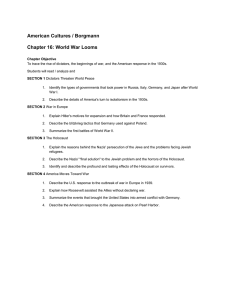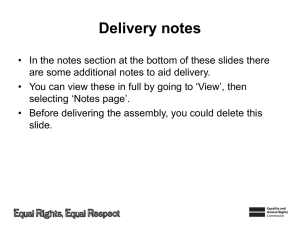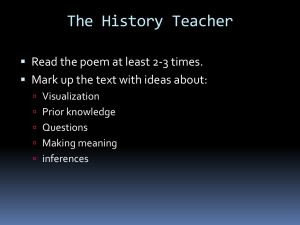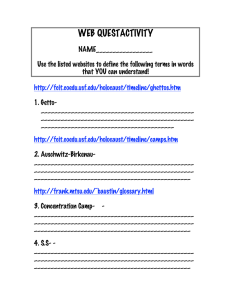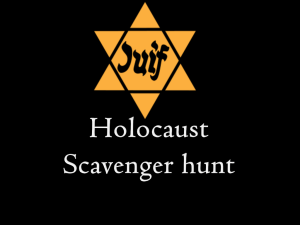Panel 5: The Path Leading from Research to Citizenship Education:
advertisement
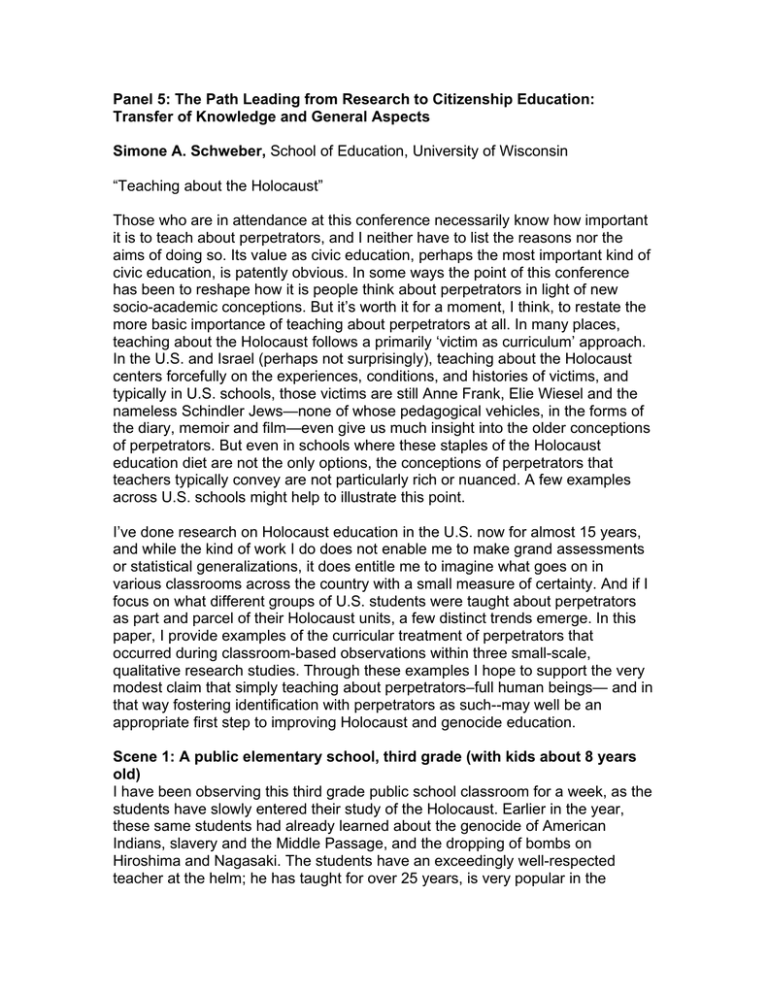
Panel 5: The Path Leading from Research to Citizenship Education: Transfer of Knowledge and General Aspects Simone A. Schweber, School of Education, University of Wisconsin “Teaching about the Holocaust” Those who are in attendance at this conference necessarily know how important it is to teach about perpetrators, and I neither have to list the reasons nor the aims of doing so. Its value as civic education, perhaps the most important kind of civic education, is patently obvious. In some ways the point of this conference has been to reshape how it is people think about perpetrators in light of new socio-academic conceptions. But it’s worth it for a moment, I think, to restate the more basic importance of teaching about perpetrators at all. In many places, teaching about the Holocaust follows a primarily ‘victim as curriculum’ approach. In the U.S. and Israel (perhaps not surprisingly), teaching about the Holocaust centers forcefully on the experiences, conditions, and histories of victims, and typically in U.S. schools, those victims are still Anne Frank, Elie Wiesel and the nameless Schindler Jews—none of whose pedagogical vehicles, in the forms of the diary, memoir and film—even give us much insight into the older conceptions of perpetrators. But even in schools where these staples of the Holocaust education diet are not the only options, the conceptions of perpetrators that teachers typically convey are not particularly rich or nuanced. A few examples across U.S. schools might help to illustrate this point. I’ve done research on Holocaust education in the U.S. now for almost 15 years, and while the kind of work I do does not enable me to make grand assessments or statistical generalizations, it does entitle me to imagine what goes on in various classrooms across the country with a small measure of certainty. And if I focus on what different groups of U.S. students were taught about perpetrators as part and parcel of their Holocaust units, a few distinct trends emerge. In this paper, I provide examples of the curricular treatment of perpetrators that occurred during classroom-based observations within three small-scale, qualitative research studies. Through these examples I hope to support the very modest claim that simply teaching about perpetrators–full human beings— and in that way fostering identification with perpetrators as such--may well be an appropriate first step to improving Holocaust and genocide education. Scene 1: A public elementary school, third grade (with kids about 8 years old) I have been observing this third grade public school classroom for a week, as the students have slowly entered their study of the Holocaust. Earlier in the year, these same students had already learned about the genocide of American Indians, slavery and the Middle Passage, and the dropping of bombs on Hiroshima and Nagasaki. The students have an exceedingly well-respected teacher at the helm; he has taught for over 25 years, is very popular in the community, and teaches about the Holocaust at the third grade because he feels it can inoculate the students against racism, the thinking that undergirds white privilege, hatred and violence. All of the parents of the students in the class, even after the unit has ended, feel that teaching about the Holocaust was utterly appropriate. “School is not and should not be a playground,” encapsulates the sentiments of these parents, as does the expression that “A few nightmares for the right reasons are simply part of a growing up.” Generally speaking, I was very impressed with this teacher for a whole variety of reasons, including his carefully scaffolded sequence of picture books, his highly inclusive range of teaching activities and the deep affection he cultivated among his students. He was without question a master teacher. He had taught about the Holocaust for a full week, reading aloud books for children, when finally a question about perpetrators arose for the first time. Mr. Kupnich was reading David Adler’s (1994) book, Hilde and Eli: Children of the Holocaust. Recommended for grades 3-7, the book follows the experiences of two victims –Hilde Rosensweig, a German shopkeeper’s daughter, and Eli Lax, a Czechoslovakian rabbi’s son—tracing their experiences against the backdrop of the rise of the Nazis, the laws against Jews, the establishment of ghettos, and conditions in Auschwitz concentration camp, where both characters are eventually murdered. The narration is bleak, the prose is stark, and the content is starker. It was the first really ‘hard content’ that the children heard. “One night in July, 1941, Eli’s cousin, Enzarick was taken away [from the ghetto]. Eli heard the screams, and after that, Eli was too frightened to sleep at night,” Mr. Kupnich read. The students sat in rapt attention, interjecting questions when they couldn’t interpret the narrator’s oblique references. (“Do you mean that [he] got taken away and killed?”—“They never saw them again, so yes, most likely, they were killed.”) Mayli had been sitting with a creased forehead for a few minutes, seemingly both confused and upset, when she finally blurted out a question: “Were the Nazis all mean?” This is the perfect entrée of course to talking about perpetrators. And, the teacher answered, “The Nazis were pretty much not very nice people.” He was quick to add that not all Germans were Nazis, and he did so by asking his students to complete his statement: “There were lots of German people who were not Nazis because some of the German people were--” “Helpers of the Jews,” one student supplied, “Jewish people,” another mentioned. This teacher’s understated remark—that the Nazis were ‘pretty much not very nice people’--encapsulated the entirety of his teaching about the perpetrators, simplifying and essentializing their all-too-human behavior. He thus presented Nazis neither as ‘ordinary men’ (Browning, 1993) nor as rabid antisemites (Goldhagen, 1996), two of the most widely circulated academic theories of perpetrator behavior at the time. Instead, the Nazis were “pretty much not very nice,” which the students easily understood as implying something much harsher and much more dismissive. As one of the third graders wrote in her journal at the end of the unit, echoing her teachers’ language almost verbatim, “They were very bad people I think.” Many students wrote the same kind of thing in different forms, writing statements such as: “Me and Jackie Chan will punch the bad guys.” One price of Mr. Kupnich’s cursory treatment of the Nazis was exacted in the students’ incomprehension. While all the students had learned that the Nazis persecuted and murdered Jews and others, none ultimately understood why, a confusion evidenced in many of their journals. “Why did they take the Jews?” one girl’s journal questioned, continuing, “They could’ve done it to some other people.” My interviews, too, revealed that none of the focus students knew about the history of anti-Semitism or understood racialization generally. Following Mr. Kupnich’s lead, they resorted to explanations that centered on being “mean.” Emmeline, for example, wrote in her journal, “I wonder if hitler [sic] was mean when he was little?” It’s not a bad question, of course; it simply points to a profoundly impoverished frame of reference for answering. When I asked the teacher about the pedagogical choice to oversimplify the perpetrators, he told me that he thought it was developmentally appropriate. The students, by virtue of their youth, tended to think in defined categories so that this explanation for perpetrator behavior fit comfortably into their cognitive patterns. Because this was a beginning point and not an end point in the students’ intellectual lives, he seemed to think it was a good enough choice. Later teachers could ‘complete the picture.’ Perhaps a bit defensively, he also justified his choice on moral-symbolic grounds, asking wasn’t it more important to spend time building empathic bridges with victims than humanizing perpetrators of mass murder. Why spend precious curricular time on perpetrators at all, he asked. It’s worth noting that this was a politically left-leaning teacher, willing to teach very anti-American content—which he did in teaching about the decimation of the Arawac Indians, for example. (His political orientation is important to add as one might expect this kind of attitude among right-leaning teachers, who tend to be opposed politically to moral nuance; just think of those teachers who support expresident George W. Bush’s uses of terms like ‘axis of evil’….) My point is simply that Nazis evoke this kind of religio-moral superiority that supports teachers in making poor curricular choices. Scene 2: An 8th grade classroom in a Lubavitch girls’ yeshivah Lubavitch Jews make up only a tiny fraction of the U.S. population, and as such, they’re not really a force to be reckoned with in terms of their schooling practices. I include a brief portrait of teaching in an 8th grade Lubavitch girls’ yeshivah nonetheless because the secular studies teacher I studied at the school was state-certified and not Lubavitch herself, and I think her views reflect more than the sanctions of the school in which she taught. Her views are commonly held beliefs, echoing the third grade teacher’s, if from a different kind of philosophical standpoint. In this classroom, the teacher very simply taught that the Nazis were incomprehensible. The main text used to teach about the Holocaust was a Jewish survivor’s memoir entitled, ‘There is always a time to die.’ The protagonist of the account was himself Jewish, but not ultra-orthodox, which meant that the text was heavily censored so as not to expose the girls to inappropriate material (about the intermingling of the sexes, for example, or the use of swear words, as another). In the context of reading this memoir, the teacher’s staunch belief in what might be called a philosophy of inexplicability emerged. The girls were reading about Jews in the Warsaw ghetto, those who were socially prominent or wealthy before the war, being shot as they stood in their nightclothes. For the girls, this reading marked their first encounter with gruesome details of death. “Were they killed because there was no room [in the ghetto]?” asked one girl, and a flurry of discussion erupted in response: “Because they were German!” one girl yelled in explanation. “Because they were Jews!” another yelled out. “Don’t say ‘because.’ There was no because,” the teacher intoned heavily, ending the discussion. In so doing, she avowed her sense that the supplying of reasons was more than unnecessary; it was almost offensive, as if reasons implied justification rather than explanation. This kind of purposeful non-explanation occurred again and again in this classroom, and not surprisingly, it showed up in the students’ lacks of understanding at the end of the unit. When asked why she thought the Holocaust occurred, one of the students said, “Because we’re the chosen nation and everyone’s always jealous of us, [and] the Germans weren’t normal. There’s no normal reason anybody would do that.” Normal here was code for comprehensible; since there were no explanations proffered for their behavior, the Germans were not comprehensible, and by extension, not normal. As another girl in the class put it, “I mean, this comes up all the time. Everything you hear that the Nazis did, you can just say, ‘How’ to. How could they do these things that a normal human being couldn’t bring themselves to do? I will never understand how they did what they did.” For these Lubavitch girls, such a statement of incomprehension was typical and comfortable. Not only did it insulate them from any commonality with the Nazis and their all-too-human behavior, but also, more generally the discourse of incomprehensibility was one the girls often employed vis a vis God. They were used to thinking about God as being inscrutable, unknowable, and beyond the human capacity for reasoning. This discourse of the incomprehensible Nazis, then, served two purposes simultaneously. On the one hand, it insulated them from the possibility of being at all like perpetrators, and on the other hand, it did so through a familiar language. Like God’s intentions, this history was and would remain incomprehensible. In considering Nazi behavior to be abnormal, unknowable and unable even to be investigated, the teacher in this school fed the girls’ moral arrogance and religious triumphalism. Not only did the girls believe themselves to be incapable of compromising behavior, but they could not deign even to discuss it in others. The starkness of the moral divide that the teacher etched through her deployment of a warumverbot reified the girls’ righteousness and supported their narrow-mindedness. If in the first case—of the third grade classroom—the teacher was protecting the innocence of young children, in this case of the Lubavitch classroom, the teacher might be said to have been protecting the insularity of the world-view of these adolescents. Scene 3: A charismatic, evangelical Christian school’s 8th grade classroom In the U.S., a much more substantial set of the population identifies as bornagain or evangelical Christian. (Estimates range between 25% at the low end and as high as 40% at the high end.) This is why I decided to study such a school’s Holocaust teachings. As at the Lubavitch yeshivah, 8th grade was considered the right time to expose students to the horrors of the Holocaust (In 8th grade, the children are approximately 13 years old. In both schools they were at the end of their middle school moment. The next year, they would move onto new schools, even if the students in both places would be sitting next to the same students.) At this school, which I called Eternal Grace, the students learned about the Holocaust through the memoir of a believing Christian, Corrie ten Boom, who wrote about the strength of her faith as she helped hide a small group of Jews and as she and her sister were imprisoned as a result. Because this was the only text the students read, they ended up with quite a warped sense of Holocaust history. Belief figured so prominently in their own lives and in the memoir of Corrie ten Boom that they considered it all-important during the Holocaust as well. One student, Dean, expressed this well. As with many of his peers, the strengths of Dean’s religion appeared immediately. In answer to our first interview question, to describe himself, he said matter-of – factly: “Alright, I’m fourteen. My religion is I’m a Christian, and I believe in God. He died for my sins.” When asked later in his interview how perpetrators were able to execute atrocities, Dean explained, “I believe the Nazis were atheists…. They didn’t believe there was a God, or it was just your life, and that was it basically.” In other words, to become perpetrators people either had to be atheists or had to dismiss the possibility of an afterlife, which for Dean, was a certainty that included eventual judgment. Since the fundamentalist Christian (Corrie ten Boom) was persecuted by Nazis, the possibility that Nazis were Christians of any sort was ruled out for most of these students. I studied this classroom during the month of September 2001, and I was at that school when the World Trade Center attacks occurred. I bring this up because some of the discussions in class in the immediate aftermath of the attacks encouraged the teacher to draw comparisons between the two events. In one session, for example, the teacher asked if any of the students, had they lived ‘during Corrie’s time,’ thought that they would have hidden Jews as Corrie did, or gotten “involved in standing up against the Gestapo.” ‘No’s’ and soft laughter filled the room. When called upon, the students said things like “I’d be a good citizen,” and “I’d follow the law.” The teacher was clearly disturbed by these responses. “Would you follow God’s law or the Gestapo law?” she asked “I’d try to do both,” one student answered. “Is there any way to follow both?” another student asked. “Do you think there is a way to follow both?” the teacher volleyed back. “If you were schizophrenic?” answered one student, and the class dissolved in giggles. I interpreted this exchange as being made possible by the constant assertion in this school and in this classroom of God’s control over events. The sense that God’s plan was constantly in motion and that God directs history so carefully, I think gave the students a diminished sense of moral obligation to act in the world. After all, if all events follow God’s plan, regardless of what one chooses to do, why act in ways that risk one’s safety? In the ensuing days, the teacher was bothered by her students’ unwillingness to even imagine themselves as rescuers, and she tried to adjust their moral compasses by equating saving Jews during the Holocaust with waging a retaliatory war on Afghanistan. Repeatedly, she asked if the students could see similarities between the two choices, arguing that, “You can’t just stand by and close your eyes to someone who is harming so many people.” The students remained unconvinced, however; they were much more willing to endorse active military measures than to consider prohibited rescue activities. One would think that this meant they had some measure of empathy or understanding of perpetrator, collaborator or bystander behavior, but this wasn’t the case. They simply couldn’t consider themselves to ever become perpetrators, almost regardless of their choices, since they were all ‘saved’ and hence were headed to heaven in their eternal afterlives. Scene 4: A public high school To briefly recapitulate the first three scenes, they might be considered bunting options in teaching. (A bunt in baseball, as I understand it, occurs when a hitter, instead of swinging as hard as possible at the incoming ball, instead switches grips at the last minute and taps it lightly. It’s a dodge, which is an oddly appropriate metaphor for what I’m describing.) In the elementary school, the teacher oversimplified to the point of parody; the Nazis were simply ‘bad guys’ in the classic drama of good guys and bad guys. In the Jewish school, Nazis were unfathomable and inhuman, impossible to learn from and not particularly worth learning about. In the Christian school, the Nazis were also utterly othered—as they couldn’t be Christian. The choices in these three scenes thus span the range from parody to farce. Public high schools in the U.S., like their elementary and middle school counterparts, are totally decentralized. That is, states govern content, and districts are almost more powerful than states. Within high schools, though curricular scope and sequences across state lines will resemble each other, social studies content varies tremendously. Teachers have tremendous autonomy in deciding how to teach (even if state-based content examinations have encroached on the decisions over what to teach). I say this because it’s important to recognize that in an odd kind of way, it’s more reliable to generalize about schools within particularist traditions (such as fundamentalist Christian schools and ultra-orthodox Jewish schools) than it is to generalize about public schools in the U.S. From region to region, very different kinds of moral lessons about the Holocaust are being learned—given, for example, the increasing homogenization of public school populations (politically, socioeconomically, etc.) …. This is all to say that you ought to take what I say about high schools with some skepticism. (Simply put, there is no ‘typical’ high school classroom.) With those cautions in place, I want to insist that U.S. students in public high school classrooms are mainly learning to identify with victims. It is the rare case in which students learn about perpetrators with any meaningful depth or empathetic influence. In one of the more radical pedagogical experiments I’ve observed, a teacher enacted a long-term simulation in her class, wherein the students were assigned to ‘play’ the parts of Jews. (As a side note, though we know that simulations are popular formats through which to teach about the Holocaust, it’s unclear how frequently they’re used. I can say that the most frequently asked question asked of the U.S. Holocaust Memorial Museum’s information line are the dimensions of boxcars, which most in the education department think are teachers seeking to use them in a classroom-based simulation.) The teacher, in the class I observed, represented all perpetrators, a choice with many intended and unintended consequences. She dictated all the action in the simulation. For the purposes of this paper, what matters is that the students identified with their victim counterparts only—their teacher was “like Hitler or something,” a role that didn’t enable the students to really, fully, honestly engage perpetration except as imagined victims of it. Like the girls at the Lubavitch yeshivah, the mostly poor Black students in this simulation didn’t learn to imagine themselves as possible perpetrators, but instead as likely victims. There are exceptions to this trend. There are, of course, teachers who teach about perpetrators (usually using the example of Stanley Milgram’s ‘obedience to authority experiments, or in rare cases, an excerpt from Christopher Browning’s Ordinary Men or Daniel Jonah Goldhagen’s Hitler’s Willing Executioners). These are few and far between, however. Most teachers teaching about the Holocaust, if they teach about perpetrators at all, teach only indirectly about ‘them.’ Thus, in many cases, Hitler stands in for all Germans and Nazis. Typically speaking, too, the metanarrative of ‘freedom and progress’ that buttresses American exceptionalism quashes the possibility of our being perpetrators. It’s simply seen as un-American. Conclusion: I know that Israeli education, though it focuses on very different Holocaust icons, is similarly perpetrator-averse. In the trips that Israeli school children and military units take to tour Poland, and in the curricula that are studied in both religious and secular schools, students are positioned to identify with victims of the Holocaust only. My sense is that this needs to stop, in both Israel and the U.S.A. It behooves no one to teach generation upon generation that they are potential victims. In Israel, it seems to justify an unchecked militarism. In the U.S.A., it does worse. I don’t mean to suggest of course that Holocaust education alone explains the U.S. occupation of Iraq or the recent Israeli war on Gaza. Holocaust education, under the best of circumstances, is simply not the only form of moral instruction. I write these lines, however, on the day that Barack Obama has been sworn into office as the 44th president of the United States, and as naïve as it may sound, I can’t help thinking optimistically about what Holocaust education could actually do if it were harnessed to new conceptions of perpetrators—or even just plain human conceptions of perpetrators. Perhaps such a shift would enable a new generation of students to question the national narratives that mask our culpability as perpetrators and potential perpetrators. In short, this new vision of Holocaust education, it seems to me, might help us remember what really matters in this world: our humanity.
